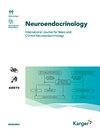昼夜节律起搏器中的细胞信号:活体成像的新发现。
IF 3.2
2区 医学
Q2 ENDOCRINOLOGY & METABOLISM
引用次数: 0
摘要
背景 "人人为我,我为人人",这是大仲马脍炙人口的小说《三个火枪手》中著名的集结号,当然也适用于组成丘脑上核(SCN)的 20,000 个细胞。这些细胞共同组成中央时钟,根据昼夜周期协调身体节律。与几乎所有身体细胞一样,单个 SCN 细胞表现出自主的昼夜节律振荡,但这种节律性只有在细胞与邻近细胞耦合后才能达到较高的精确度和稳健性。因此,了解 SCN 细胞核心节律之外的功能网络组织是昼夜节律生物学的一个重要问题。本综述总结了我们最近研究的主要成果,这些成果证明了在自由活动的小鼠体内记录 SCN 细胞的可行性,以及细胞内钙在多个时间尺度上变化的重要性。本文章由计算机程序翻译,如有差异,请以英文原文为准。
Cell signaling in the circadian pacemaker: new insights from in vivo imaging.
BACKGROUND
"One for all, and all for one", the famous rallying cry of The Three Musketeers, in Alexandre Dumas's popular novel, certainly applies to the 20,000 cells composing the suprachiasmatic nuclei (SCN). These cells work together to form the central clock that coordinates body rhythms in tune with the day-night cycle. Like virtually every body cell, individual SCN cells exhibit autonomous circadian oscillations, but this rhythmicity only reaches a high level of precision and robustness when the cells are coupled with their neighbors. Therefore, understanding the functional network organization of SCN cells beyond their core rhythmicity is an important issue in circadian biology.
SUMMARY
The present review summarizes the main results from our recent study demonstrating the feasibility of recording SCN cells in freely moving mice and the significance of variations in intracellular calcium over several timescales.
KEY MESSAGE
We discuss how in vivo imaging at the cell level will be pivotal to interrogate the mammalian master clock, in an integrated context that preserves the SCN network organization, with intact inputs and outputs.
求助全文
通过发布文献求助,成功后即可免费获取论文全文。
去求助
来源期刊

Neuroendocrinology
医学-内分泌学与代谢
CiteScore
8.30
自引率
2.40%
发文量
50
审稿时长
6-12 weeks
期刊介绍:
''Neuroendocrinology'' publishes papers reporting original research in basic and clinical neuroendocrinology. The journal explores the complex interactions between neuronal networks and endocrine glands (in some instances also immunecells) in both central and peripheral nervous systems. Original contributions cover all aspects of the field, from molecular and cellular neuroendocrinology, physiology, pharmacology, and the neuroanatomy of neuroendocrine systems to neuroendocrine correlates of behaviour, clinical neuroendocrinology and neuroendocrine cancers. Readers also benefit from reviews by noted experts, which highlight especially active areas of current research, and special focus editions of topical interest.
 求助内容:
求助内容: 应助结果提醒方式:
应助结果提醒方式:


